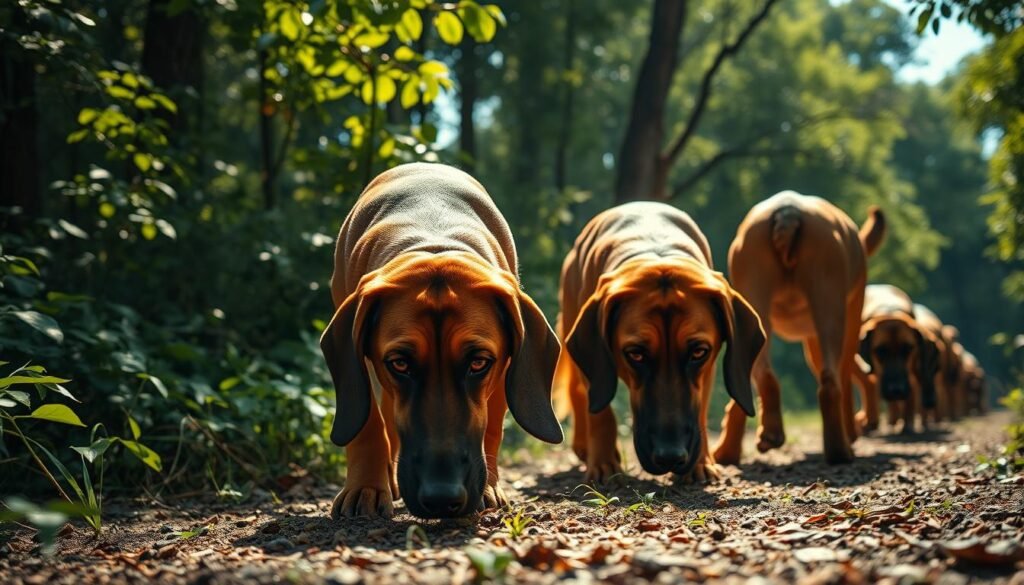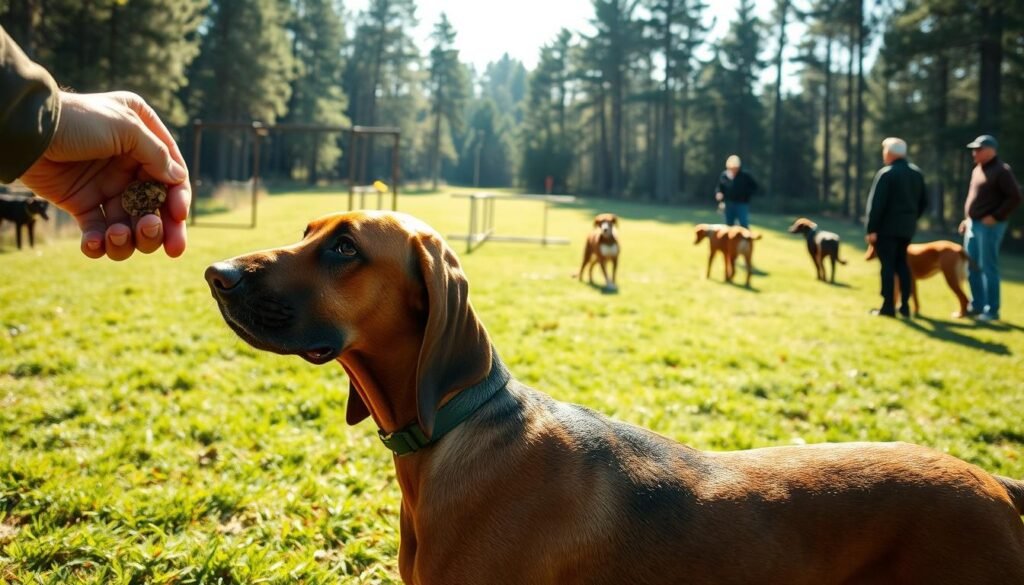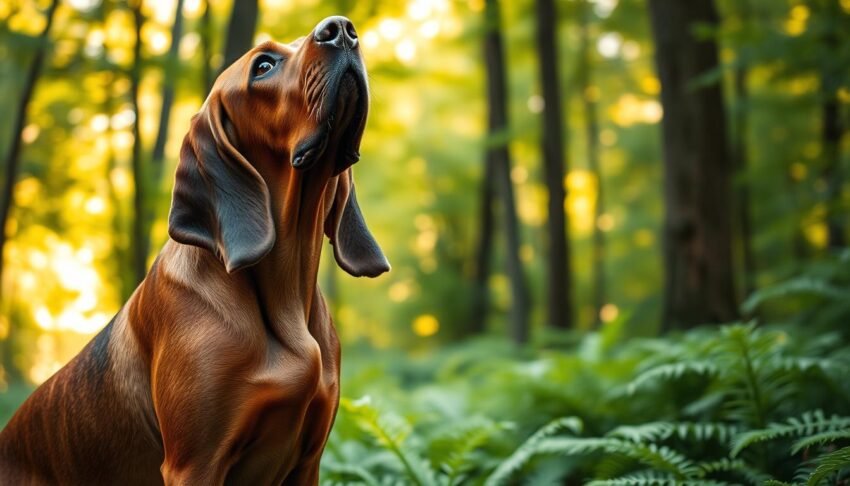As you consider bringing a Bloodhound into your family, you should know that this breed is renowned for its exceptional tracking abilities, making them a popular choice for search and rescue operations and law enforcement1. With their distinctive physical characteristics, such as droopy ears and soulful eyes, Bloodhounds are a beloved breed among dog enthusiasts. You’ll find that Bloodhounds are generally large dogs, with males weighing between 90-110 pounds and females weighing between 80-100 pounds, and they have a short, smooth coat that requires minimal grooming, making them a great choice for families2.
As a potential Bloodhound owner, you should be aware that this breed is known for its calm and patient personality, but they do require regular exercise and training to prevent boredom and destructive behavior. Bloodhounds are highly skilled tracking dogs, and their sense of smell is estimated to be 10,000 to 100,000 times more acute than that of humans2. If you’re looking for a loyal companion that can keep up with your active lifestyle, a Bloodhound may be the perfect fit.
Key Takeaways
- Bloodhounds are skilled tracking dogs with a keen sense of smell2.
- They are generally large dogs with a short, smooth coat1.
- Bloodhounds are calm and patient, but require regular exercise and training2.
- They are highly skilled in search and rescue operations and law enforcement1.
- Bloodhounds can follow a scent for up to 130 miles1.
Introduction to Bloodhounds
Bloodhounds are known for their exceptional tracking abilities, making them a popular choice for canine hunting and search and rescue dogs3. With their powerful noses and determination, they can follow scents over long distances, demonstrating their value as breeds for tracking3.
In terms of their physical characteristics, Bloodhounds typically weigh between 46-54 kg (101-119 lb) for males and 40-48 kg (88-106 lb) for females4. Their height ranges from 64-72 cm (25-28 in) for males and 58-66 cm (23-26 in) for females4.
Some key facts about Bloodhounds include:
- Their life expectancy is around 9.3 years4.
- They are prone to certain health issues, such as gastric dilatation-volvulus (bloat)4 and5.
- They require regular exercise and a balanced diet to stay healthy5.
Bloodhounds have been used in law enforcement for decades, and are known for their ability to track scents in a variety of environments3. Their unique traits, such as their loose skin folds, allow scents to be trapped and intensified, giving them an advantage in tracking3.
The Incredible Sense of Smell
As you explore the world of Bloodhounds, you’ll discover that their sense of smell is one of their most impressive features. With up to 300 million olfactory receptors in their noses, they can detect scents that are too faint for humans to detect6. This unique ability makes them highly effective in canine detection and as working dogs. Their intelligence, adaptability, and high activity level also make them an excellent choice for search and rescue operations, law enforcement, and hunting.
When it comes to tracking scents, Bloodhounds have a unique ability to follow trails in a variety of environments, including urban and rural areas. They can detect scents that are over 300 hours old6 and track trails for over 130 miles6. This is due to their highly developed olfactory center, which is 40 times larger than that of humans6. In comparison to other breeds, Bloodhounds have a distinct advantage in canine detection, making them a valuable asset in law enforcement and search and rescue operations.
Here are some key facts about Bloodhounds and their sense of smell:
- They have up to 300 million olfactory receptors in their noses6
- They can detect scents that are over 300 hours old6
- They can track trails for over 130 miles6
- Their olfactory center is 40 times larger than that of humans6
In real-life applications, Bloodhounds are used in search and rescue operations, law enforcement, and hunting. Their ability to detect scents and track trails makes them an invaluable asset in these fields. With their intelligence, adaptability, and high activity level, Bloodhounds are an excellent choice for canine detection and as working dogs7.
Bloodhounds in Search and Rescue

Bloodhounds are often utilized in search and rescue operations to track missing persons, thanks to their incredible sense of smell8. As mantrailing dogs, they can follow scent trails accurately for several miles, showcasing their endurance and scent-tracking capability8. In law enforcement, search and rescue dogs like Bloodhounds are used to track suspects and locate evidence, making them invaluable assets in these operations.
The popularity of Bloodhounds in search and rescue operations can be attributed to their ability to track scents over long distances, effectively locating lost and missing individuals8. However, it’s essential to note that Bloodhounds have limitations, such as being unable to consistently use a scent article to pick up a track and follow it9. Despite these limitations, Bloodhounds remain highly recognized for their abilities and are often used in high-profile search and rescue operations.
To become a search and rescue dog, Bloodhounds must undergo extensive training and certification, which includes socialization with people and other animals, as well as training in obedience and tracking8. This training is crucial in preparing Bloodhounds for the challenges they may face in search and rescue operations, making them effective mantrailing dogs.
Some notable success stories of Bloodhounds being used in search and rescue operations include the location of missing children and adults8. These stories highlight the importance of Bloodhounds in search and rescue operations and demonstrate their value as search and rescue dogs.
Health and Care for Bloodhounds
As a Bloodhound owner, it’s essential to prioritize your dog’s health and well-being. Bloodhounds, like all scent hounds, require regular veterinary care to prevent and treat common health issues10. With their unique physiology, Bloodhounds are prone to certain health problems, such as hip dysplasia and eye issues10. Regular check-ups and screenings can help identify these issues early on, ensuring your Bloodhound lives a long and healthy life.
In terms of nutritional needs, Bloodhounds require a balanced diet that includes high-quality protein sources, such as meat and fish11. They also need regular exercise and mental stimulation to prevent boredom and destructive behavior. A daily food intake of 4 to 8 cups of dry food, divided into two meals, is recommended10. Additionally, Bloodhounds need regular grooming, including weekly brushing and daily cleaning of facial wrinkles10.
Here are some key health and care tips for Bloodhounds:
- Regular veterinary check-ups to prevent and treat common health issues10
- A balanced diet with high-quality protein sources11
- Regular exercise and mental stimulation to prevent boredom and destructive behavior
- Weekly brushing and daily cleaning of facial wrinkles10
By following these tips and prioritizing your Bloodhound’s health and care, you can help ensure they live a long and happy life as a beloved tracking dog and scent hound11.
Training Your Bloodhound

As a potential Bloodhound owner, you’re likely eager to start training your new companion. With their strong instinct for canine hunting and tracking, Bloodhounds require a structured approach to training. According to research, the optimal age to start training a Bloodhound puppy is around 8 weeks old12. At this stage, you can begin introducing basic commands such as “sit,” “stay,” and “come,” which are essential for any dog, including those used in search and rescue dogs operations.
When it comes to training your Bloodhound for tracking, it’s essential to start with short distances, such as 15-20 yards, and gradually increase the length of the trail as they become more confident12. Consistency is key, and weekly training sessions are recommended to continue skill development12. Bloodhounds respond well to positive reinforcement, making treats an essential part of training13. It’s also crucial to maintain excitement and fun in training, as this will help keep your Bloodhound engaged and motivated.
Some key tips for training your Bloodhound include:
- Keep training sessions short, ideally 15 minutes or less13
- Use consistent commands and positive reinforcement13
- Introduce various challenges, such as different runners, locations, and terrains12
- Make sure to provide immediate feedback and rewards13
By following these tips and being patient, consistent, and positive, you can help your Bloodhound become a skilled tracking dog, well-suited for breeds for tracking and other activities. Remember, training is an ongoing process that requires time, effort, and dedication, but with the right approach, you and your Bloodhound can achieve great things13.
Living with a Bloodhound
When considering bringing a Bloodhound into your family, it’s essential to understand their needs and personality. Bloodhounds are known for their calm and patient nature, making them an excellent choice for families with children14. They are also highly social and thrive in environments where they can interact with their human family members and other pets15.
In terms of living conditions, Bloodhounds require a spacious area to exercise and move around. A large yard or a comfortable living space with enough room for them to stretch out is ideal16. They also need regular exercise, such as daily walks and playtime, to maintain their physical and mental health.
Here are some key things to consider when living with a Bloodhound:
- They require regular grooming to prevent matting and tangling of their coats16
- They need training and socialization from an early age to ensure they interact well with other pets and people15
- They are prone to certain health issues, such as hip dysplasia and ear infections, and require regular veterinary care16
Overall, living with a Bloodhound can be a highly rewarding experience, but it’s crucial to understand their needs and provide the necessary care and attention14. With proper training, socialization, and care, Bloodhounds can thrive as beloved family pets and loyal companions.
Fun Facts About Bloodhounds
Bloodhounds are known for their incredible tracking abilities, making them valuable assets in canine detection and as working dogs. According to17, Bloodhounds have been used in law enforcement for decades, and are known for their ability to track scents in a variety of environments. Their sense of smell is estimated to be at least 1,000 times stronger than that of humans18, and they can follow a scent trail for over 130 miles18.
Some notable achievements of Bloodhounds include their use in search and rescue operations and their ability to detect scents that are up to 300 hours old1918. They are also highly versatile and are used in a variety of roles, including hunting and companionship. As mantrailing dogs, they are able to track the scent of a specific person, making them valuable assets in law enforcement.
In addition to their tracking abilities, Bloodhounds are also known for their friendly and tolerant nature, making them a great breed for families and hunters alike. With proper training and care, Bloodhounds can thrive as both working dogs and beloved companions.
Choosing the Right Bloodhound
When selecting a Bloodhound, it is essential to consider several factors, including the breeder’s reputation, the dog’s temperament, and your lifestyle. You should look for a breeder who prioritizes health, temperament, and socialization, and is committed to transparency and communication20. Bloodhounds are highly trainable, and are known for their ability to learn quickly and follow commands21.
A responsible breeder will provide you with information about the dog’s ancestry, health clearances, and temperament. They will also help you determine whether a Bloodhound is the right fit for your family and living situation. As a scent hound, Bloodhounds have a unique ability to track scents, making them ideal for tracking dogs and canine hunting22.
Some key things to consider when choosing a Bloodhound include:
- Size: Bloodhounds are large dogs, with an average height of 61-66 cm and weight of 45-50 kg20.
- Coat: Bloodhounds have a short, smooth coat that requires regular grooming21.
- Personality: Bloodhounds are known for their gentle, affectionate nature, but they can also be strong-willed and independent21.
- Training: Bloodhounds are highly trainable, but they can be stubborn at times, requiring patient and consistent training21.
By considering these factors and working with a reputable breeder, you can find a Bloodhound that is well-suited to your lifestyle and needs. With proper care and training, a Bloodhound can make a wonderful companion for active families or individuals who enjoy canine hunting and tracking dogs20.
Conclusion: The Legacy of Bloodhounds
As we look to the future of the Bloodhound breed, it is essential to prioritize their health, longevity, and the continued recognition of their remarkable contributions23. These scent-tracking superstars have played a vital role in search and rescue operations, law enforcement, and hunting for centuries, and their impact on these fields is undeniable24. With a unique ability to follow scents across various terrains, Bloodhounds have proven themselves invaluable assets in a wide range of applications24.
Breeders and enthusiasts must work together to ensure the preservation of the Bloodhound’s working capabilities, while also addressing concerns around inbreeding and the potential for inconsistencies in performance quality23. By celebrating the breed’s achievements and fostering responsible breeding practices, we can help secure the Bloodhound’s legacy for generations to come.
For those considering Bloodhound ownership, it is essential to carefully evaluate your lifestyle and ability to provide the necessary care and attention23. These loyal companions require a significant investment of time and resources, but the rewards of owning a Bloodhound can be immeasurable. With their unwavering devotion and impressive tracking abilities, Bloodhounds can be beloved family members and valuable partners in a variety of endeavors.
FAQ
What is a Bloodhound?
What are the physical characteristics of a Bloodhound?
What is the history and purpose of the Bloodhound breed?
What makes the Bloodhound’s sense of smell so impressive?
How are Bloodhounds used in search and rescue operations?
What are some common health issues in Bloodhounds?
What is the best way to train a Bloodhound?
What are the ideal living conditions for a Bloodhound?
What are some fun facts about Bloodhounds?
How do I choose the right Bloodhound?
Source Links
- 18 of the Smartest Dog Breeds – https://www.petmd.com/dog/general-health/smartest-dog-breeds
- Dogs’ Dazzling Sense of Smell – https://www.pbs.org/wgbh/nova/article/dogs-sense-of-smell/
- No title found – https://www.akc.org/expert-advice/dog-breeds/bloodhound-history/
- Bloodhound – https://en.wikipedia.org/wiki/Bloodhound
- Bloodhound Dog Breed Guide and Pet Insurance | Healthy Paws Pet Insurance – https://www.healthypawspetinsurance.com/blog/bloodhound-dog-breed-guide-and-pet-insurance
- How Good Is a Bloodhound’s Sense of Smell? Breed Facts & FAQ – Dogster – https://www.dogster.com/dog-breeds/how-good-is-a-bloodhounds-sense-of-smell
- Underdogs ~ The Bloodhound’s Amazing Sense of Smell | Nature | PBS – https://www.pbs.org/wnet/nature/underdogs-the-bloodhounds-amazing-sense-of-smell/350/
- How to Train Your Bloodhound Dog to Search and Rescue – https://wagwalking.com/training/search-and-rescue-1
- Bloodhounds: The Myth and Fiction About Their Tracking Abilities – https://leerburg.com/bloodhound.htm?srsltid=AfmBOopIS_PO_zZTHPP_8BMIwLzjtUnShp9X422YwdIpODSA6H97UOJ3
- Learn All About the Noble Bloodhound – https://www.thesprucepets.com/bloodhound-dog-breed-profile-4782183
- Bloodhound – https://www.petmd.com/dog/breeds/bloodhound
- Bloodhound Training – https://www.bloodhoundmantrackers.org/bloodhound-training.html
- How to Train a Bloodhound: 7 Vet-Approved Tips – Dogster – https://www.dogster.com/dog-training/how-to-train-a-bloodhound
- Living with Bloodhounds – https://www.coloradocountrylife.coop/living-with-bloodhounds/
- Are Bloodhounds Good Pets & Good Indoor Dogs? – https://dogtime.com/reference/144305-bloodhound-good-pet-friendly-house-inside-indoor-dog
- Can a Bloodhound Live in An Apartment? – https://iheartdogs.com/can-a-bloodhound-live-in-an-apartment/
- Bloodhound Facts – Wisdom Panel™ Dog Breeds – https://www.wisdompanel.com/en-us/dog-breeds/bloodhound
- What Makes Bloodhounds Good Detectives? – https://www.wonderopolis.org/wonder/what-makes-bloodhounds-good-detectives/
- 15 Interesting Bloodhound Facts You’ll Love to Discover – Dogster – https://www.dogster.com/lifestyle/bloodhound-facts
- Bloodhound – https://www.pdsa.org.uk/pet-help-and-advice/looking-after-your-pet/puppies-dogs/large-dogs/bloodhound
- Ultimate Bloodhound Grooming Guide: Tips for a Healthy Hound – https://citizenshipper.com/blog/ultimate-bloodhound-grooming-guide-tips-for-a-healthy-hound/
- Bloodhounds: The Myth and Fiction About Their Tracking Abilities – https://leerburg.com/bloodhound.htm?srsltid=AfmBOoqJ_eZPVqPSkS9-B8JVXQPV6soZLphvwDGaEHz0NzM0JZ3Ewyjf
- Improving The Bloodhound – Jackal’s Old Country Blood – https://jackalsoldcountryblood.com/improving-the-bloodhound/
- What Were Bloodhounds Originally Bred For? – https://iheartdogs.com/what-were-bloodhounds-originally-bred-for/


